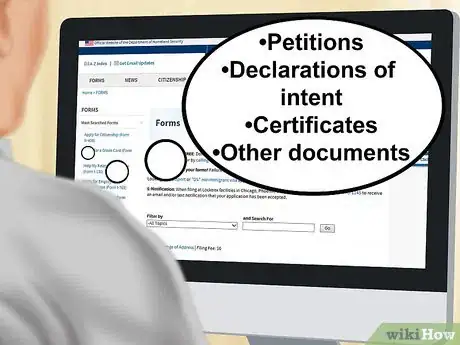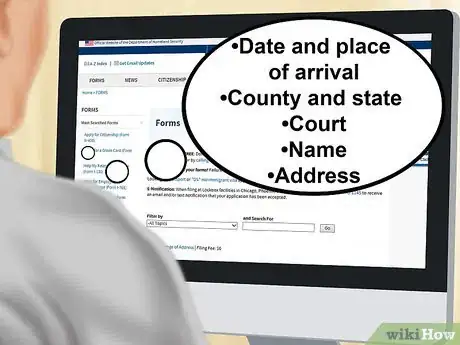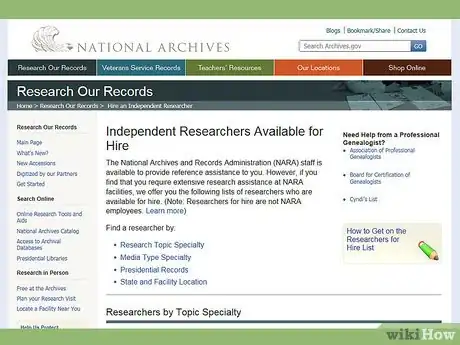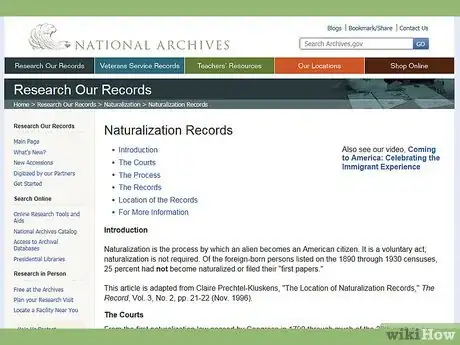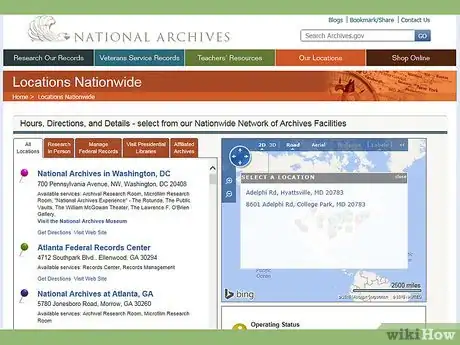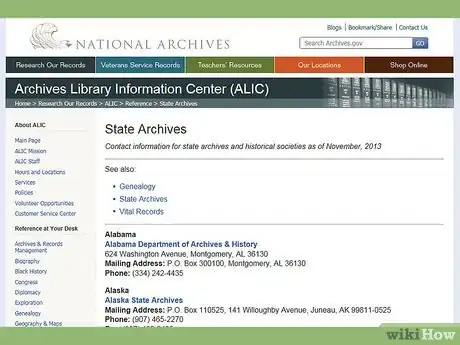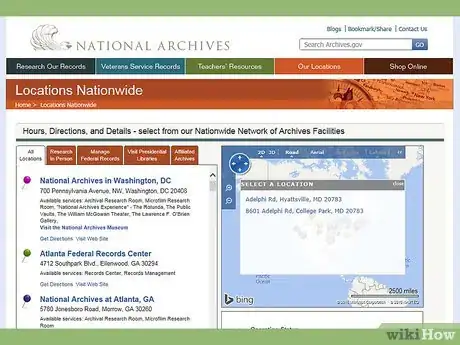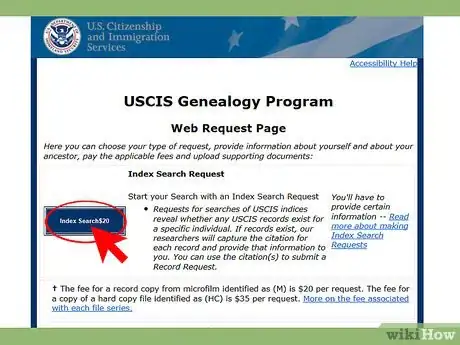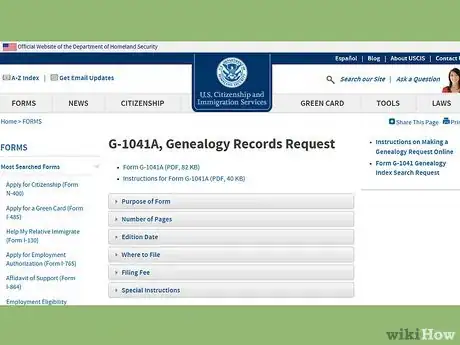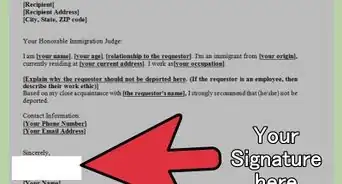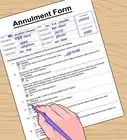This article was co-authored by Clinton M. Sandvick, JD, PhD. Clinton M. Sandvick worked as a civil litigator in California for over 7 years. He received his JD from the University of Wisconsin-Madison in 1998 and his PhD in American History from the University of Oregon in 2013.
There are 8 references cited in this article, which can be found at the bottom of the page.
This article has been viewed 33,598 times.
Naturalization records are created when a non-citizen applies to become a naturalized United States citizen. You may need an additional copy of your own naturalization records, or you may be searching for information on ancestors who immigrated to the United States. Before 1906, aliens could be naturalized in many courts around the country, and those courts retained the naturalization records. By 1906, however, all naturalization records were forwarded to the Immigration and Naturalization Services (INS). When the naturalization occurred will determine in large part where you begin your search.
Steps
Preparing to Search
-
1Identify what records you want. Naturalization records vary depending on when they were created. Before 1906, most naturalization records included petitions, declarations of intent, certificates, and other documents.[1] After 1906, the Bureau of Immigration and Naturalization (INS) was created and the forms were standardized. Sometimes these documents contain information about the alien’s background. For this reason, people researching their family histories sometimes want to collect their relatives’ naturalization records.
- If all you want is another copy of your Certificate of Naturalization because it has been lost, stolen, destroyed, or mutilated, then you can request another copy from USCIS (United States Citizenship and Immigration Services). See Replace a Naturalization Certificate.
-
2Gather information. In order to find the naturalization records, you need to know some basic information. First, you should know when the naturalization occurred. Before 1906, naturalizations could have happened in a variety of state or local courts, which stored their own naturalization records. If you need records before that time, then you will need to search at the appropriate court. To help in your search, you should gather as much of the following information as possible:[2]
- The immigrant’s date and place of arrival into the country.
- The county and state where the naturalization occurred.
- The court in which the naturalization took place.
- The name of the person naturalized, including alternate names.
- The town or county where the person settled and lived.
Advertisement -
3Get a death certificate. You might need a death certificate, depending on who you are searching for. For example, if you want to perform an index search using the USCIS genealogy program, you will need a death certificate or other proof of death for the immigrant.[3]
- To get a death certificate, see Acquire a Death Certificate.
-
4Think about hiring an independent researcher. If you are searching for records and don’t feel comfortable with your research skills, you might want to hire a professional researcher. Researchers can be particularly helpful when searching for pre-1906 records.
- The National Archives retains a list of professional researchers. These are not employees of the National Archives. Instead, they are people who have performed research in the National Archives and asked to be put on the list.
- You can find the list by visiting http://www.archives.gov/research/hire-help/index.html#topic and selecting “Immigration, Emigration, and Naturalization Records” under “Researchers by Topic Specialty.”
- You also might want to hire a genealogy researcher not included on the National Archives list. To find one, you can perform an internet search or look in your Yellow Pages.
Searching for Pre-1906 Records
-
1Search the National Archives. Before 1906, U.S. citizenship could be granted by many different “courts of record.” These included municipal, county, state, or federal courts around the country. Accordingly, most records will have been retained by those courts. However, a few records and indexes have been donated to the National Archives in Washington, D.C.[4]
- To see what pre-1906 records are held by the National Archives, visit the page at http://www.archives.gov/research/naturalization/naturalization.html#loc.
- Very few naturalization records have been published online. However, you can stop by the National Archives and view the microfilm. The National Archives is located at 700 Pennsylvania Avenue, NW, Washington, DC 20408.[5]
-
2Find the appropriate NARA facility. Some pre-1906 naturalizations were performed in federal courts. The National Archives and Records Administration (NARA) regional facilities may have those records. You will need to contact the appropriate regional facility, which will depend on the state in which the naturalization occurred.
- You can find a map of regional facilities at http://www.archives.gov/locations/. Click on the regional offices to see which state’s records that regional facility has collected.
- You may be able to order reproductions of Naturalization Records online from NARA facilities.[6] You will need to create a username and password.
-
3Contact the appropriate state agency. If you need records for naturalizations performed in state, county, or local courts, then you should contact the state archives.[7] Each state has an agency that can either search for the records or provide you with more information about how to search for them.
- The National Archives maintains a list of state agencies you can contact on its website at http://www.archives.gov/research/alic/reference/state-archives.html.
-
4Search multiple courts, if necessary. Before 1906, applicants sometimes filed a declaration of intent in one court and then the petition years later in a different court.[8] For this reason, you might have to search in more than one court to find all of the records.
- Plan on searching in courts for each town or county in which the immigrant lived.
Searching for Records After 1906
-
1Find the appropriate regional facility. Records after 1906 will also be held in NARA regional facilities. You can search by visiting the website for the appropriate regional center.
- To find a list of NARA regional facilities, visit http://www.archives.gov/locations/.
-
2Use the USCIS genealogy program. After 1906, USCIS (then called INS) received a copy of all naturalization records. You can search for immigration records of any deceased immigrant through this program.[9] You can begin with an Index Search to identify if any records exist for the immigrant. You can perform an index search online or through the mail.
- To search online, you can visit USCIS at https://genealogy.uscis.dhs.gov/ and click on “Index Search $20,” which is what you will pay for the search. Enter the information requested: the immigrant’s first and last names, as well as the country of birth and birthdate (an estimate is okay).[10]
- If the immigrant’s date of birth was less than 100 years ago (or if you only knew an estimated date of birth), you will need to submit proof of death. You will need to upload a scanned copy of a death certificate.[11]
- If you want to perform an index search using a paper application, then you should download Form G-1041 and the Instructions available from USCIS at http://www.uscis.gov/g-1041. You can then fill out the Form G-1041 and return it to the address provided on the form.
- If you need to provide proof of death, then supply a copy of the death certificate. Originals will not be returned to you.[12]
- To search online, you can visit USCIS at https://genealogy.uscis.dhs.gov/ and click on “Index Search $20,” which is what you will pay for the search. Enter the information requested: the immigrant’s first and last names, as well as the country of birth and birthdate (an estimate is okay).[10]
-
3Submit a record request to USCIS. If you use the genealogy program with USCIS, then you will be given a citation for each relevant record after an index search is performed. You can then order the records.[13] You may submit requests online or through the mail.
- To order online, you can visit https://genealogy.uscis.dhs.gov/ and click on “Record with Case ID $20 or $35.” You will need the file numbers that were given to you as a result of the Index Search.
- If you want to submit a paper request, then download Form G-1041A and its Instructions, available at http://www.uscis.gov/g-1041a. You will then mail your request to the address listed on the form.
- The fee for records is $20 per request for microfilm copy and $35 per request for any hard copy.[14]
References
- ↑ https://familysearch.org/learn/wiki/en/United_States_Naturalization_and_Citizenship
- ↑ http://www.uscis.gov/history-and-genealogy/genealogy/instructions-making-genealogy-request-online
- ↑ http://www.uscis.gov/history-and-genealogy/genealogy/instructions-making-genealogy-request-online
- ↑ http://www.archives.gov/research/naturalization/#find
- ↑ http://www.archives.gov/locations/
- ↑ https://eservices.archives.gov/orderonline/start.swe?SWECmd=Start&SWEHo=eservices.archives.gov
- ↑ http://www.archives.gov/research/naturalization/#find
- ↑ https://familysearch.org/learn/wiki/en/United_States_Naturalization_and_Citizenship
- ↑ http://www.uscis.gov/genealogy
- ↑ http://www.uscis.gov/history-and-genealogy/genealogy/instructions-making-genealogy-request-online
- ↑ http://www.uscis.gov/history-and-genealogy/genealogy/instructions-making-genealogy-request-online
- ↑ http://www.uscis.gov/history-and-genealogy/genealogy/instructions-making-genealogy-request-online
- ↑ https://genealogy.uscis.dhs.gov/
- ↑ https://genealogy.uscis.dhs.gov/
